Seagate Hard Disks (MFM & RLL)
Last revision of this page: November 23, 2024
- ST-506
- ST-406 Family
- ST-157 Family
- ST-124
- ST-125
- ST-138
- ST-157
- ST-225 Family
- ST-251 Family
- Information
- References

According to James N. Porter [8] the (total) worldwide shipment of all 5.25" hard disks has been (in thousands):
- 1983: 1,214.9
- 1984: 2,722.8
- 1985: 3,637.9
- 1986: 5,804.4
- 1987: 8,162.3
- 1988: 8,753.1 (peak)
- 1989: 8,306.2
MFM & RLL
Most hard drives of the pre-IDE period used MFM (Modified Frequency Modulation) encoding. Floppy drives still do. MFM was not the only twin- cable hard drive interface though: aside from its close relative RLL, there was also the now long forgotten high-end competitor to SCSI, EDSI.
MFM was relatively simple to implement, and quite robust. RLL (Run Length Limited) encoding used the same electrical interface and cables but a different data format (much as Morse Code and Baudot code are different). An RLL format squeezes the information more tightly onto the disc and increases the effective areal density by 50%.
So a 10MB MFM drive, if formatted with an RLL controller, could now store 15MB, and can be up to 50% faster too. Almost all MFM drives had 17 sectors per track, but RLL drives squeezed 26, or even 32 sectors onto each track. RLL did, however, require a very accurate drive mechanism.
Early attempts to increase speed and storage capacity by adding an after- market RLL controller to an MFM drive system often resulted in poor reliability. This gave RLL an undeserved bad name. Later on, many drive manufacturers introduced RLL certified models, and these were generally just as reliable as their cheaper, smaller MFM drives.
Technically, however, there was no such thing as an 'RLL drive'. The drive type (MFM or RLL) was solely determined by the low-level format, and this in turn, depended on the drive controller card. In theory, any ST-506 (two- cable) drive could be formatted with either an MFM or an RLL controller. Not many early drives, however, were capable of taking an RLL format reliably. [9]
I always use my RLL hard disks with a MFM controller (e.g. WD1003 or WD1006). Here you will find information how to low-level format (LLF) hard disks with MS-DOS DEBUG.
How to Read Seagate Model Numbers
ST-277R-0 PR
S .... Seagate
T .... Technology
2 .... form-factor 5.25" half-high
(1 = 3.5" half-high, 4 = 5.25" full-high)
(there is no form factor 5)
77 ... MBytes unformatted
(06, 12, 25, 38, 50, 51, 77 MBytes)
R .... ST412/RLL
(unspec. = ST412/MFM)
(N = SCSI)
0 .... standard access time
(1) faster
PR ... Paired solution
AMI-286 BIOS Hard Disk Types
Type Cyl. Head Sect. Write Land Seagate
p-comp Zone Model
------------------------------------------------------------------
1 306 4 17 128 305 ST-412
2 615 4 17 300 615 ST-225
...
6 615 4 17 -1 615 (ST-238R)
...
40 820 6 17 820 820 ST-251, (ST-277R)
...
47 -- user defined --
47 667 4 17 667 670 (ST-250R)
------------------------------------------------------------------
(alternatively with MFM recording)
Testsystem
My testsystem is an AT 80286 :
- AMI-286 BIOS
- WD1006-MM1
- MS-DOS 6.22
I have read in some of my hard disks with the MFM emulator from David Gesswein and can emulate them on my AT 80286 completely silently without any problems.
I operate my hard disks shown here outside the case and with an external 5v/12V power supply (e.g. Phobya 4Pin molex, 70W). This or similar types are also available with 35W. But beware, these old hard disks still consume a lot of power, see ST-412.
ST-406

Technical Specifications
Seek time: ............ 85 ms
Data transfer rate: ... 0.5 MB/s
Power standby: ........ 3.7/1.8 amps
First cust. shipment .. 1981
-----
Interface: ............ ST412
Recording method ...... MFM
Capacity unformatted: . 6.38 MByte
Capacity formatted: ... 5 MByte
Cylinder: ............. 306
Heads: ................ 2
Discs: ................ 1
Sector/track: ......... 17
Bytes/sector: ......... 512
AMI 286 drive type: ... 47 (user defined)
ST-412
You'll go a long way to find a drive that's older than this one: the ST-412 powered many of the first hard disk-equipped micro computers, notably the original IBM PC-XT.
In 1979 industry veteran Al Shugart, already well-known as the former CEO of floppy drive pioneer Shugart Associates, got together with Finis Conner to co-found a new company, Shugart Technology, which was soon to become Seagate. This was the beginning of storage as we know it.
Shugart was responsible for the genesis of the two hard drive interfaces that were to dominate the PC world for decades, SCSI and ST-506/412. In 1980 Shugart produced the world's first 5.25 inch hard drive: the 5MB ST-506. The 10MB ST-412 followed in 1981, and with its selection by IBM for the PC-XT, Seagate was on the way to becoming the world's largest drive manufacturer. [3]
I have used this fixed disk in a Kaypro 10; no problems.
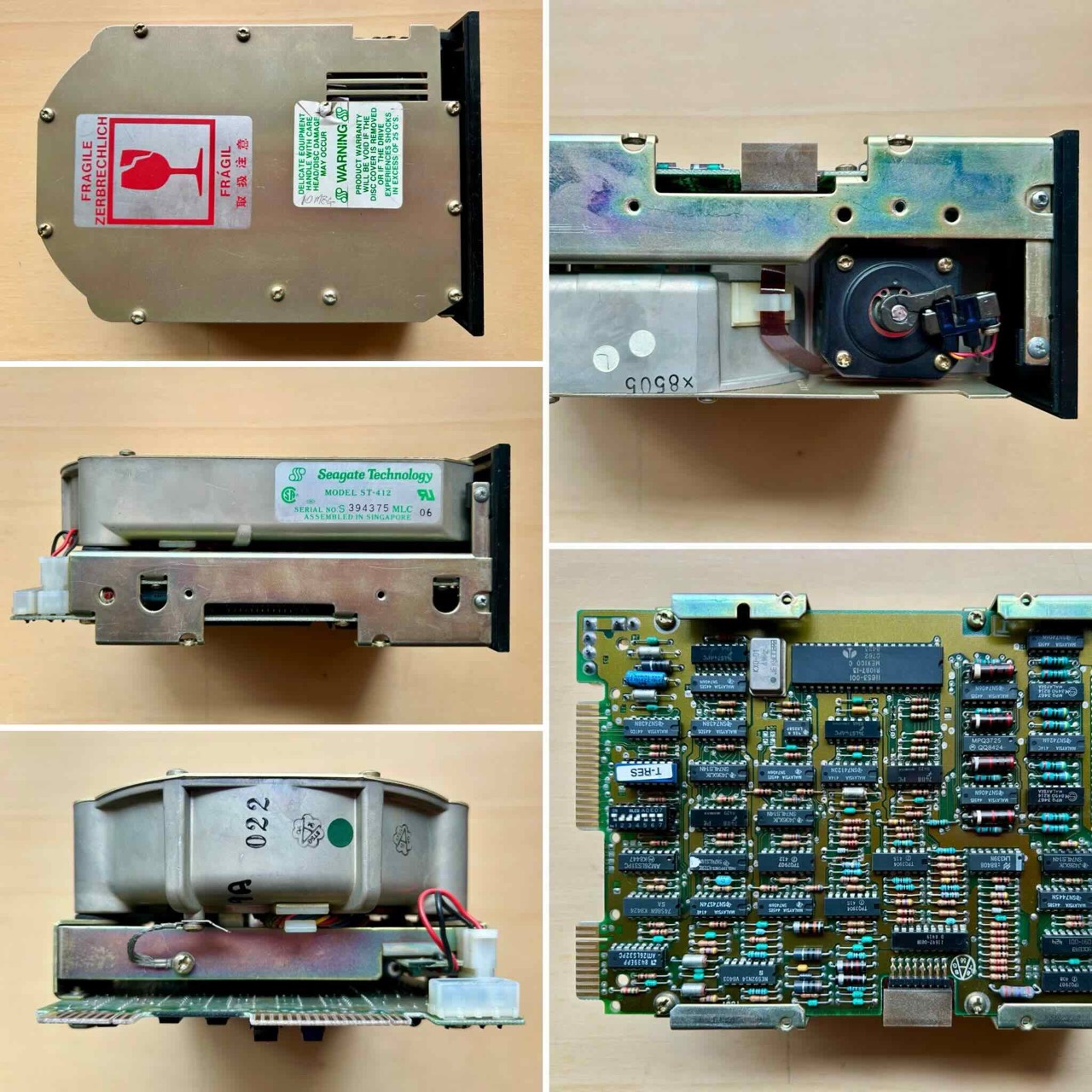
Technical Specifications
Seek time: ............ 85 ms
Data transfer rate: ... 0.5 MB/s
Power standby: ........ 3.7/1.8 amps
First cust. shipment .. 1981
-----
Interface: ............ ST412
Recording method ...... MFM
Capacity unformatted: . 12.8 MByte
Capacity formatted: ... 10 MByte
Cylinder: ............. 306
Heads: ................ 4
Discs: ................ 2
Sector/track: ......... 17
Bytes/sector: ......... 512
AMI 286 drive type: ... 1
ST-419

Technical Specifications
Seek time: ............ 85 ms
Data transfer rate: ... 0.5 MB/s
Power standby: ........ 3.7/1.8 amps
First cust. shipment .. 1981
-----
Interface: ............ ST412
Recording method ...... MFM
Capacity unformatted: . 19.14 MByte
Capacity formatted: ... 15 MByte
Cylinder: ............. 306
Heads: ................ 6
Discs: ................ 3
Sector/track: ......... 17
Bytes/sector: ......... 512
AMI 286 drive type: ... 47 (user defined)
ST-225
This is my favorite hard disk.
Old reliable. Allowing for market growth over the years, the ST-225 was undoubtedly the best-selling hard drive of all time, as astonishing in its own way as the Z-80 was in its.
The ST-225 was the single most common 20MB drive, and certainly the longest lived. It set the pattern for what would become the traditional, almost the inevitable, entry-level Seagate: a surprisingly low price, ugly styling, modest but reasonable performance, and outstanding reliability.
Incredibly, we would still see ST-225s once in a blue moon right up to the end of the century, fifteen or twenty years old by then, and going just as strong as ever. [6]
From the last sentence I conclude that this site was created before the turn of the millennium. I own a total of eight ST-225s, which are possibly 35-40 years old and still work.
Asking ChatGPT: "How many Seagate ST-225 hard disks were sold in total?"
The **Seagate ST-225**, a 20-megabyte hard disk introduced in 1984, was a best-seller during the early personal computing era. While exact sales numbers are not publicly documented, it is estimated that **millions of units** were sold worldwide. This model's success was due to its reliability, compatibility with the ST-506 interface (widely used at the time), and affordability. It became a standard storage option for many early IBM PC compatibles, significantly contributing to its widespread adoption. If you're looking for a precise number, this would likely require consulting Seagate's historical sales records or industry reports from that period.

I assume that the hard disks with the serif label came onto the market first.
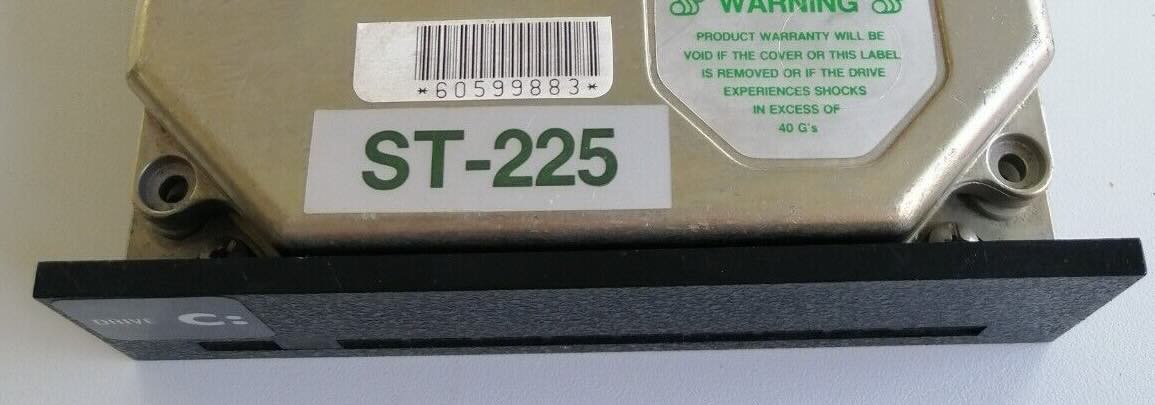
Technical Specifications
Seek time: ............ 65 ms
Data transfer rate: ... 0.625 MB/s
Power standby: ........ 14.8 W
First cust. shipment .. Oct 1984
-----
Interface: ............ ST412
Recording method: ..... MFM
Capacity unformatted: . 25.6 MByte
Capacity formatted: ... 21.4 MByte
Cylinder: ............. 615
Discs: ................ 2
Heads: ................ 4
Sector/track: ......... 17
Bytes/sector: ......... 512
AMI 286 drive type: ... 2
root@beaglebone:~# mfm/mfm_read -a
Board revision C detected
Found drive at select 1
Drive RPM 3600.2
Matches count 34 for controller WD_1006
Header CRC: Polynomial 0x1021 length 16 initial value 0xffff
Sector length 512
Data CRC: Polynomial 0x140a0445 length 32 initial value 0xffffffff
Selected head 4 found 0, last good head found 3
Read errors trying to determine sector numbering, results may be in error
Number of heads 4 number of sectors 17 first sector 1
Interleave (not checked): 1 10 2 11 3 12 4 13 5 14 6 15 7 16 8 17 9
Drive supports buffered seeks (ST412)
No sectors readable from cylinder 615
Disk has recalibrated to track 0
Stopping end of disk search due to recalibration
Number of cylinders 615, 21.4 MB
Command line to read disk:
--format WD_1006 --sectors 17,1 --heads 4 --cylinders 615 --header_crc 0xffff,0x1021,16,0 --data_crc 0xffffffff,0x140a0445,32,6 --sector_length 512 --retries 50,4 --drive 1
mfm/mfm_read --format WD_1006 --sectors 17,1 --heads 4 --cylinders 615 --header_crc 0xffff,0x1021,16,0 --data_crc 0xffffffff,0x140a0445,32,6 --sector_length 512 --retries 50,4 --drive 1 -e st225-d_60977488.ext -m st225-d_60977488.emu -t st225-d_60977488.tra
Found cyl 0 to 614, head 0 to 3, sector 1 to 17
Expected 41820 sectors got 41820 good sectors, 0 bad header, 0 bad data
0 sectors marked bad or spare
0 sectors corrected with ECC. Max bits in burst corrected 0
Track read time in ms min 29.087709 max 614.972042 avg 40.920432
-rw-r--r-- 1 root root 51286316 Nov 12 08:52 st225-d_60977488.emu
-rw-r--r-- 1 root root 21411840 Nov 12 08:52 st225-d_60977488.ext
-rw-r--r-- 1 root root 164151819 Nov 12 08:52 st225-d_60977488.tra
ST-238R
The ST-238 was initially sold as a normal MFM hard disk with 20 MB. However, as it was basically of very good quality, it was also advertised as having 30 MB using a RLL controller. Only later was it sold as a real RLL hard disk with the designation ST-238R and ST-238R PR. [1]
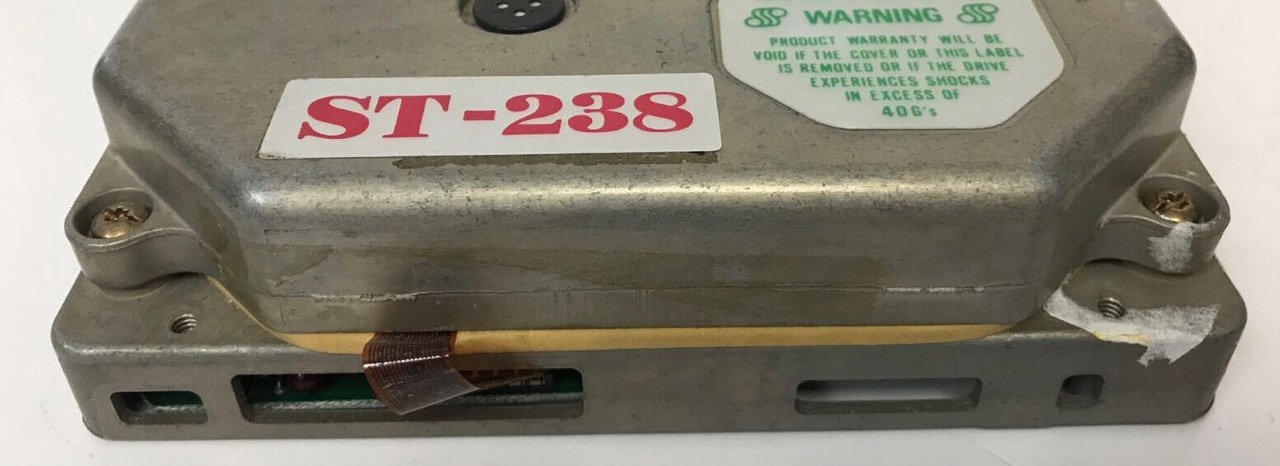
I assume that the hard disks with the serif label came onto the market first.


The Seagate - Universal Installation Handbook (see below) also explicitly mentions that the early ST-238 fixed disks did not have the R suffix.
Technical Specifications
Seek time: ............ 65 ms
Data transfer rate: ... 0.937 MB/s
Power standby: ........ 14.8 W
-----
Interface: ............ ST412
Recording method: ..... RLL (2,7)
Capacity unformatted: . 38.4 MByte
Capacity formatted: ... 32.7 MByte
Cylinder: ............. 615
Discs: ................ 2
Heads: ................ 4
Sector/track: ......... 26
Bytes/sector: ......... 512
AMI BIOS drive type: .. ?
-----
Interface: ............ ST412
Recording method: ..... MFM
Capacity formatted: ... 21.4 MByte
Cylinder: ............. 615
AMI 286 drive type: ... 6
root@beaglebone:~# mfm/setup_mfm_read
Rev C or D Board
root@beaglebone:~# mfm/mfm_read -a
Board revision C detected
Found drive at select 1
Returning to track 0
Drive RPM 3599.3
Matches count 34 for controller WD_1006
Header CRC: Polynomial 0x1021 length 16 initial value 0xffff
Sector length 512
Data CRC: Polynomial 0x140a0445 length 32 initial value 0xffffffff
Selected head 4 found 0, last good head found 3
Read errors trying to determine sector numbering, results may be in error
Number of heads 4 number of sectors 17 first sector 1
Interleave (not checked): 1 2 3 4 5 6 7 8 9 10 11 12 13 14 15 16 17
Drive supports buffered seeks (ST412)
No sectors readable from cylinder 615
Disk has recalibrated to track 0
Stopping end of disk search due to recalibration
Number of cylinders 615, 21.4 MB
Command line to read disk:
--format WD_1006 --sectors 17,1 --heads 4 --cylinders 615 --header_crc 0xffff,0x1021,16,0 --data_crc 0xffffffff,0x140a0445,32,6 --sector_length 512 --retries 50,4 --drive 1
mfm/mfm_read --format WD_1006 --sectors 17,1 --heads 4 --cylinders 615 --header_crc 0xffff,0x1021,16,0 --data_crc 0xffffffff,0x140a0445,32,6 --sector_length 512 --retries 50,4 --drive 1 -e st238-c.ext -m st238-c.emu -t st238-c.tra
Found cyl 0 to 614, head 0 to 3, sector 1 to 17
Expected 41820 sectors got 41820 good sectors, 0 bad header, 0 bad data
0 sectors marked bad or spare
0 sectors corrected with ECC. Max bits in burst corrected 0
Track read time in ms min 28.039125 max 626.162500 avg 39.593152
-rw-r--r-- 1 root root 51286316 Jul 18 00:02 st238-c.emu
-rw-r--r-- 1 root root 21411840 Jul 18 00:02 st238-c.ext
-rw-r--r-- 1 root root 149194923 Jul 18 00:02 st238-c.tra
ST-250R PR
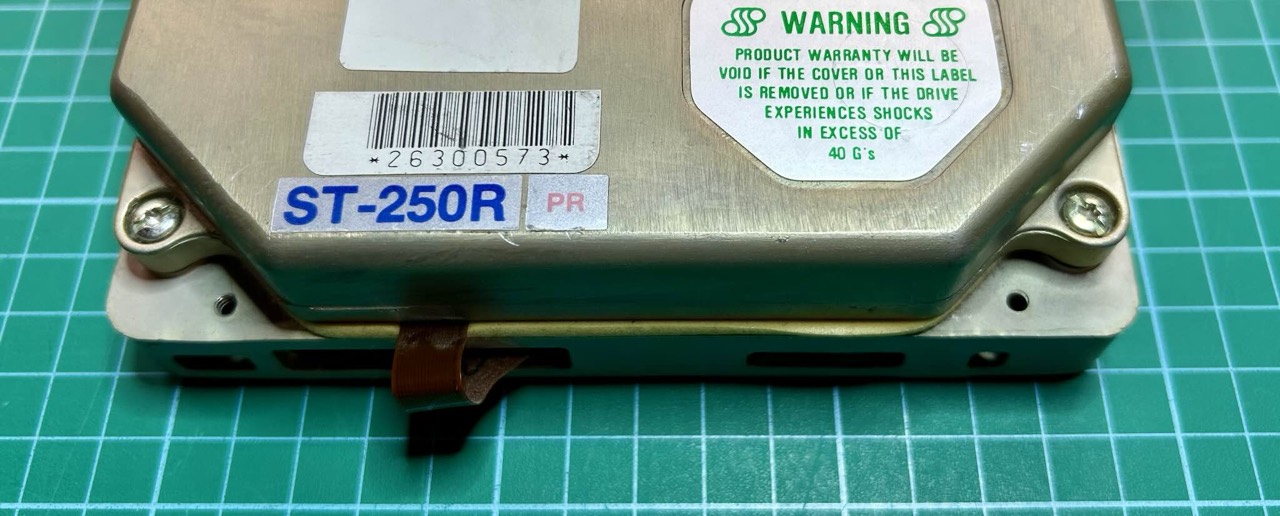
Technical Specifications
Seek time: ............ 70 ms
Data transfer rate: ... 0.938 MB/s
Power standby: ........ 14,8 W
-----
Interface: ............ ST412
Recording method: ..... RLL (2,7)
Capacity unformatted: . 50.0 MByte
Capacity formatted: ... 42.3 MByte
Cylinder: ............. 667
Discs: ................ 2
Heads: ................ 4
Sector/track: ......... 31
Bytes/sector: ......... 512
AMI 286 drive type: ... ?
-----
Interface: ............ ST412
Recording method: ..... MFM
Capacity formatted: ... 22.1 MByte
Cylinder: ............. 667
Heads: ................ 4
Sexctor/track: ........ 17
Bytes/sector: ......... 512
AMI 286 drive type: ... 47
ST-251
I have completely reinstalled my Seagate ST-251 (SN 371119): Media analysis, low-level formatting, FDISK and high-level formatting with MS-DOS 6.22. Then I read the disk with my MFM-Emulator and copied the image. Now I can use my AT 80286 with two hard disks, each 42 MB in size.
There were several versions of this long-lived drive: the 28ms ST-251-1 was much faster than the standard model (ST-251-0 or plain ST-251), and then there was the ST-277R, which was a tweaked-up RLL variant. ... The ST-251 made a unique hollow knocking noise on start-up, once heard never forgotten, by far the most distinctive sound of any drive yet made. [5]
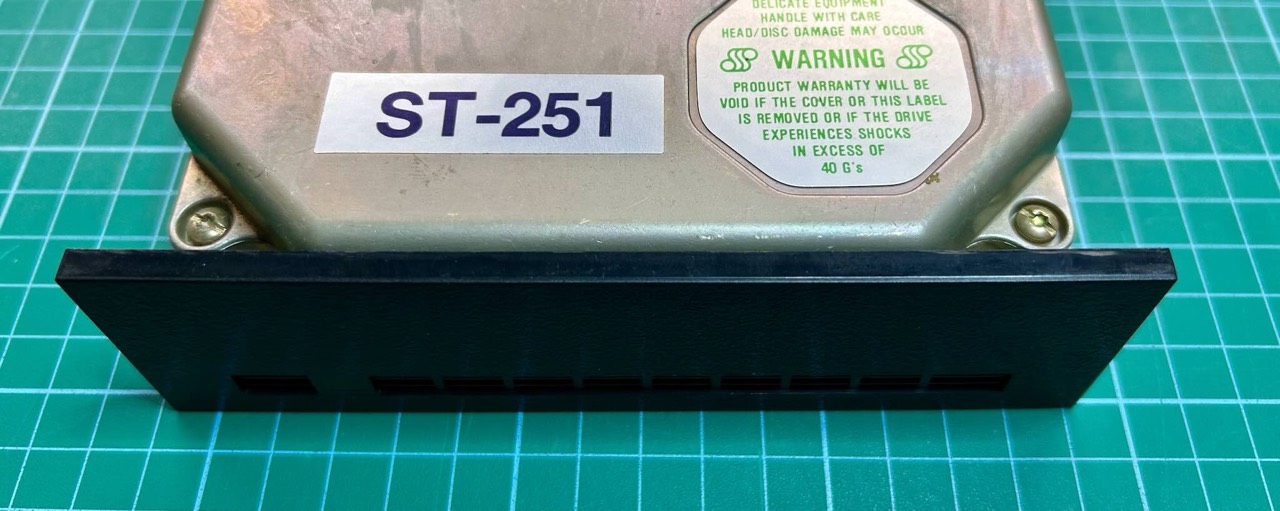
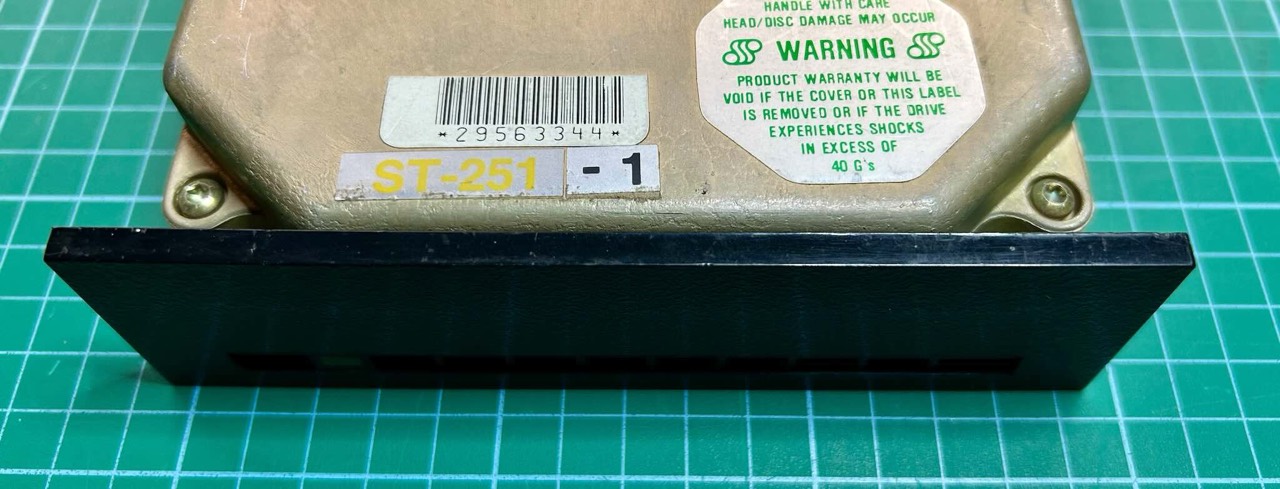
Technical Specifications
Seek time: ............ 28 ms
Data transfer rate: ... 0.625 MB/s
Power standby: ........ 12 W
-----
Interface: ............ ST412
recording method: ..... MFM
Capacity unformatted: . 51.2 MByte
Capacity formatted: ... 42.8 MByte
Cylinder: ............. 820
Discs: ................ 3
Heads: ................ 6
Sector/track: ......... 17
Bytes/sector: ......... 512
AMI 286 drive type: ... 40
root@beaglebone:~# mfm/mfm_read -a
Board revision C detected
Found drive at select 1
Returning to track 0
Drive RPM 3599.7
Matches count 34 for controller WD_1006
Header CRC: Polynomial 0x1021 length 16 initial value 0xffff
Sector length 512
Data CRC: Polynomial 0x140a0445 length 32 initial value 0xffffffff
Selected head 8 found 0, last good head found 5
Read errors trying to determine sector numbering, results may be in error
Number of heads 6 number of sectors 17 first sector 1
Interleave (not checked): 1 2 3 4 5 6 7 8 9 10 11 12 13 14 15 16 17
Drive supports buffered seeks (ST412)
No sectors readable from cylinder 820
Disk has recalibrated to track 0
Stopping end of disk search due to recalibration
Number of cylinders 820, 42.8 MB
Command line to read disk:
mfm_read --format WD_1006 --sectors 17,1 --heads 6 --cylinders 820 --header_crc 0xffff,0x1021,16,0 --data_crc 0xffffffff,0x140a0445,32,6 --sector_length 512 --retries 50,4 --drive 1
mfm_read -a -e st251-c_371119.ext -m st251-c_371119.emu -t st251-c_371119.tra
Found cyl 0 to 819, head 0 to 5, sector 1 to 17
Expected 83640 sectors got 83640 good sectors, 0 bad header, 0 bad data
0 sectors marked bad or spare
0 sectors corrected with ECC. Max bits in burst corrected 0
Track read time in ms min 30.599417 max 694.791792 avg 38.902583
-rw-r--r-- 1 root root 102572396 Nov 12 07:29 st251-c_371119.emu
-rw-r--r-- 1 root root 42823680 Nov 12 07:29 st251-c_371119.ext
-rw-r--r-- 1 root root 395838157 Nov 12 07:29 st251-c_371119.tra
ST-277R -1 PR
I have used this fixed disk in a Kaypro 10 with the Advent TurboROM v3.4; no problems.

Technical Specifications
Seek time: ............ 28 ms
Data transfer rate: ... 0.937 MB/s
Power standby: ........ 12 W
-----
Interface: ............ ST412
Recording method: ..... RLL (2,7)
Capacity unformatted: . 76.7 MByte
Capacity formatted: ... 65.5 MByte
Cylinder: ............. 820
Discs: ................ 3
Heads: ................ 6
Sector/track: ......... 26
Bytes/sector: ......... 512
AMI 286 drive type: ... ?
-----
Interface: ............ ST412
Recording method: ..... MFM
Capacity formatted: ... 42 MByte
AMI 286 drive type: ... 40
root@beaglebone:~# mfm/mfm_read -aBoard revision C detected
Found drive at select 1
Drive RPM 3602.6
Matches count 34 for controller WD_1006
Header CRC: Polynomial 0x1021 length 16 initial value 0xffff
Sector length 512
Data CRC: Polynomial 0x140a0445 length 32 initial value 0xffffffff
Selected head 8 found 0, last good head found 5
Read errors trying to determine sector numbering, results may be in error
Number of heads 6 number of sectors 17 first sector 1
Interleave (not checked): 1 2 3 4 5 6 7 8 9 10 11 12 13 14 15 16 17
Drive supports buffered seeks (ST412)
No sectors readable from cylinder 820
Disk has recalibrated to track 0
Stopping end of disk search due to recalibration
Number of cylinders 820, 42.8 MB
Command line to read disk:
--format WD_1006 --sectors 17,1 --heads 6 --cylinders 820 --header_crc 0xffff,0x1021,16,0 --data_crc 0xffffffff,0x140a0445,32,6 --sector_length 512 --retries 50,4 --drive 1
mfm/mfm_read --format WD_1006 --sectors 17,1 --heads 6 --cylinders 820 --header_crc 0xffff,0x1021,16,0 --data_crc 0xffffffff,0x140a0445,32,6 --sector_length 512 --retries 50,4 --drive 1 -e st277r1-c_27556045.ext -m st277r1-c_27556045.emu -t st277r1-c_27556045.tra
Found cyl 0 to 819, head 0 to 5, sector 1 to 17
Expected 83640 sectors got 83640 good sectors, 0 bad header, 0 bad data
0 sectors marked bad or spare
0 sectors corrected with ECC. Max bits in burst corrected 0
Track read time in ms min 30.920958 max 751.969875 avg 39.149730
-rw-r--r-- 1 root root 102572396 Nov 12 08:01 st277r1-c_27556045.emu
-rw-r--r-- 1 root root 42823680 Nov 12 08:01 st277r1-c_27556045.ext
-rw-r--r-- 1 root root 395618299 Nov 12 08:01 st277r1-c_27556045.tra
Information
- Seagate Hard Disk Classification (Thomas Brase, v0.2, 24.11.2024)
- Seagate Universal Installation Handbook (1987)
- The ST400 Family (406, 412, 419) - The Value Series (May 1982)
- ST506-412 OEM-Manual (Apr 1982)
- ST-225 OEM-Manual (Oct 1985)
- Seagate Products (1988)
- Seagate - World Class Data Storage (1990)
References
- (↑) PC Magazine, 9 Jun 1987, page 160
- (↑) eBay sales pictures
- (↑) Redhill, Hard Drive History, Seagate ST-412
- (↑) Seagate - World Class Data Storage, page iv, 1990
- (↑) Redhill, hard drive history, Seagate ST-251
- (↑) Redhill, hard drive history, Seagate ST-225
- (↑) Seagate advertisement, Sep 1986; source unknown
- (↑) James N. Porter, DISK/TREND Report, RSLIDE4A.SR9,1999
- (↑) Redhill, MFM and RLL
- (↑) Radio Museum, UK